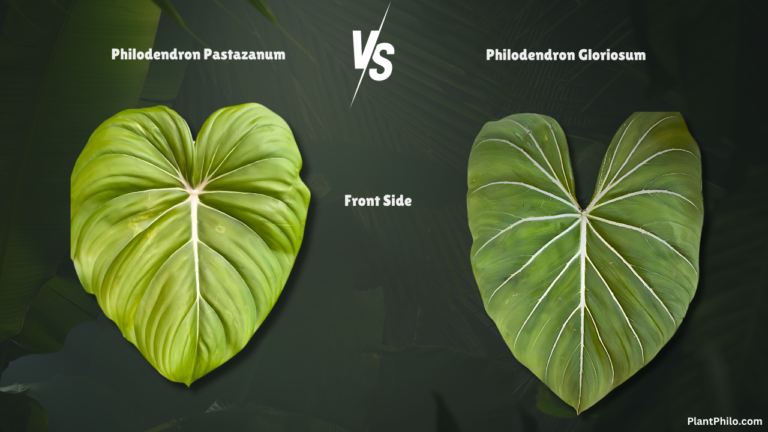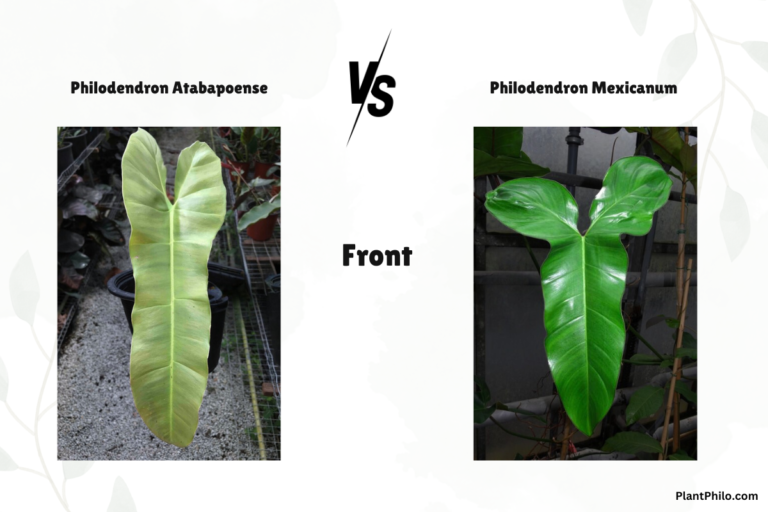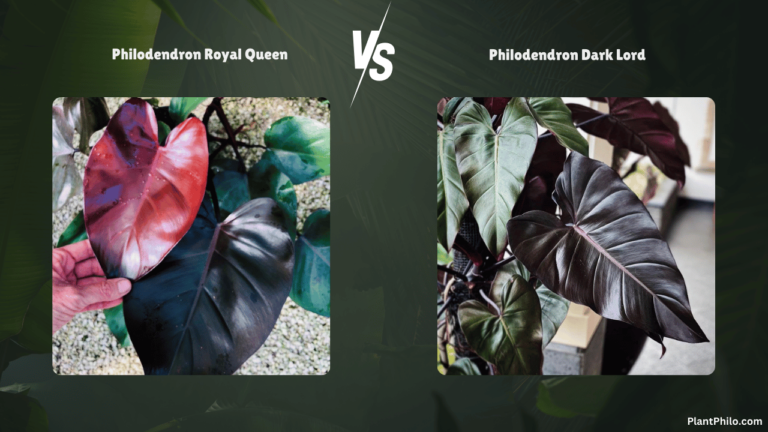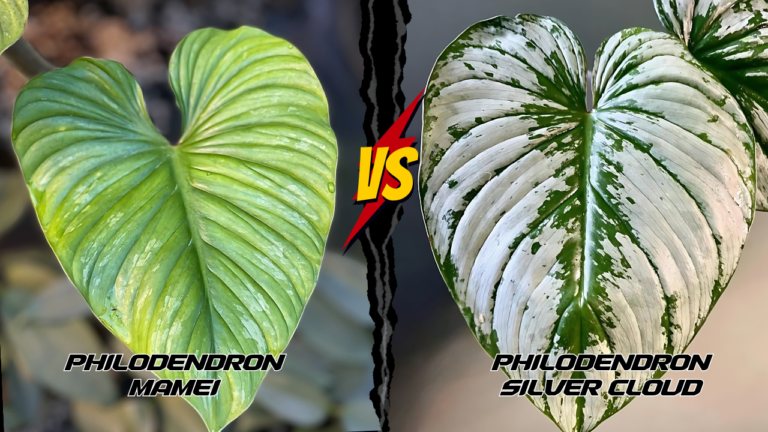Philo Scandens vs. Cordatum: We’ll Help You Identify & Decide
Philodendron Scandens and Cordatum are two names that often cause confusion and head-scratching among plant enthusiasts. These heartleaf beauties, with their cascading vines and charming foliage, are beloved houseplants, but their similarities can leave even seasoned gardeners feeling perplexed.
If you’ve ever found yourself staring at a plant tag, wondering, “Is this a Scandens or a Cordatum?” you’re not alone. Fear not, fellow plant parent! We’re here to guide you through this verdant labyrinth, shedding light on the subtle differences and care needs of each plant.
By the end of this journey, you’ll be armed with the knowledge to confidently identify and nurture these tropical gems, bringing a touch of the jungle into your home without the fear of misidentification.
Philodendron Scandens vs. Cordatum: Can You Spot the Difference?
At first glance, these two Philodendrons might seem like identical twins, separated at birth in the heart of the rainforest. But look closer, and you’ll start to notice subtle differences that set them apart. Let’s break down their key features side-by-side:
| Feature | Philodendron Scandens | Philodendron Cordatum |
| Leaf Shape | Heart-shaped with a more elongated tip | Heart-shaped with a rounder, broader base |
| Leaf Size | Smaller, typically 2-4 inches long | Larger, can grow up to 6-8 inches long |
| Leaf Texture | Thinner, slightly papery | Thicker, more leathery |
| Petiole | Slender and green | Thicker and sometimes reddish |
| Growth Habit | Vining, fast-growing | Vining, fast-growing |
| Mature Size | Can trail up to several feet | Can trail up to several feet |
| Light Requirements | Adaptable, tolerates low light but thrives in bright, indirect light | Prefers bright, indirect light |
| Water Requirements | Water when the top inch of soil is dry | Water when the top inch of soil is dry |
| Humidity | Moderate to high (50-70%) | Moderate to high (50-70%) |
| Temperature | 65-80°F (18-27°C) | 65-80°F (18-27°C) |
| Soil | Well-draining potting mix | Well-draining potting mix |
| Fertilizer | Fertilize monthly during the growing season with a diluted liquid fertilizer | Fertilize monthly during the growing season with a diluted liquid fertilizer |
| Common Pests & Diseases | Spider mites, mealybugs, scale, root rot | Spider mites, mealybugs, scale, root rot |
| Propagation | Stem cuttings | Stem cuttings |
| Toxicity | Toxic to pets and humans if ingested | Toxic to pets and humans if ingested |
| Variegated Forms | Numerous variegated cultivars available (e.g., ‘Brasil,’ ‘Micans,’ ‘Lemon Lime’) | Typically solid green, but variegated forms exist (e.g., ‘Variegata’) |
Unraveling Their Roots: Origins and Growth Habits
Just like people, plants are shaped by their origins and growth habits. Knowing where these Philodendrons hail from and how they naturally grow gives us valuable clues about their care preferences.
Philodendron Scandens:
This adaptable climber is native to the Caribbean and Central America. In its natural habitat, it scrambles over rocks and trees, its heart-shaped leaves reaching for the dappled sunlight filtering through the canopy.
Its vining habit and tolerance for low light make it a popular choice for hanging baskets and indoor spaces with limited natural light.
Philodendron Cordatum:
This species, often simply called the “Heartleaf Philodendron,” is also native to the Caribbean and South America. It shares the same vining growth habit as Scandens but tends to have larger, thicker leaves and prefers brighter light conditions. It’s a classic houseplant that has been gracing homes for generations.
Care Tips: Nurturing Your Heartleaf Beauties
Both Scandens and Cordatum are relatively low-maintenance plants, but they do have some specific care requirements to keep them looking their best.
- Light: Both plants prefer bright, indirect light. Scandens can tolerate low light conditions, but their growth may become leggy, and their leaves may lose their vibrant color. Cordatum prefers brighter light to maintain its lush foliage.
- Water: Water when the top inch of soil is dry. Allow excess water to drain to prevent root rot.
- Soil: A well-draining potting mix is essential for both plants. Look for a mix that contains perlite, coco coir, or orchid bark to ensure proper drainage and aeration.
- Humidity: Both plants appreciate moderate to high humidity (50-70%). You can increase humidity by misting regularly, using a pebble tray, or running a humidifier.
- Temperature: Both plants prefer warm temperatures between 65-80°F. Avoid cold drafts and sudden temperature changes.
- Fertilizer: Fertilize monthly during the growing season (spring and summer) with a balanced liquid fertilizer diluted to half strength.
- Pruning: Prune regularly to maintain shape and encourage new growth. You can also propagate your plants from stem cuttings.
- Pests & Diseases: Keep an eye out for common pests like spider mites, mealybugs, and scale. Treat infestations promptly with insecticidal soap or neem oil. Root rot can be a problem if the soil is kept too wet. Ensure proper drainage and avoid overwatering.
FAQs: Clearing the Air
Is Philodendron Cordatum the same as Philodendron Scandens?
No, they are distinct species, although they are often confused due to their similar appearance and common name, “Heartleaf Philodendron.”
Which plant is easier to care for, Scandens or Cordatum?
Both plants are relatively easy to care for, but Scandens is generally considered more tolerant of low light conditions.
Can I grow these plants outdoors?
Yes, but only in warm, tropical climates. They are not frost-tolerant.
How often should I repot my Philodendron?
Repot every 1-2 years in the spring or summer when the plant becomes rootbound.
Why are the leaves on my Philodendron turning yellow?
Yellowing leaves can be a sign of overwatering, underwatering, or nutrient deficiencies. Check the soil moisture and adjust your watering accordingly. You may also need to fertilize your plant.
Can I propagate these plants from leaf cuttings?
No, Philodendrons cannot be propagated from leaf cuttings. You’ll need to take stem cuttings with at least one node.
Are these plants toxic to pets?
Yes, both Scandens and Cordatum are toxic to pets if ingested. Keep them out of reach of curious cats and dogs.
How do I clean the leaves of my Philodendron?
Gently wipe the leaves with a damp cloth to remove dust and grime. Avoid using harsh chemicals or leaf shine products.
Why is my Philodendron leggy?
Leggy growth is often a sign of insufficient light. Move your plant to a brighter location or provide supplemental artificial light.
Where can I buy Philodendron Scandens and Cordatum?
These plants are readily available at most garden centers, nurseries, and online plant retailers.
Choosing Your Heartleaf Companion
Choosing between Philodendron Scandens and Cordatum ultimately comes down to personal preference and your growing conditions.
If you’re looking for an adaptable, low-light tolerant plant with smaller leaves, Scandens might be your perfect match. If you prefer a plant with larger, thicker leaves and have access to brighter light, Cordatum could be the one for you.
No matter which plants you choose, remember that both Scandens and Cordatum are beautiful, easy-care houseplants that will bring a touch of the tropics into your home. With a little love and attention, they will thrive and provide you with years of enjoyment.





